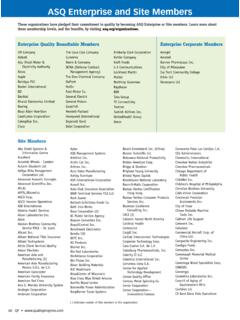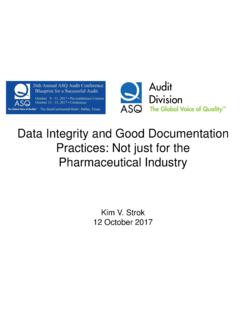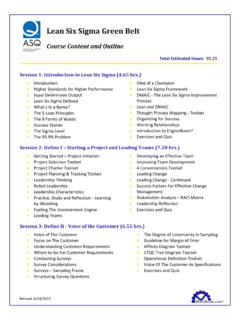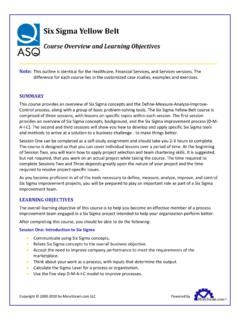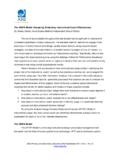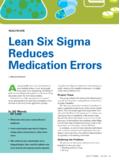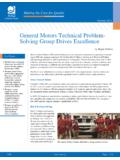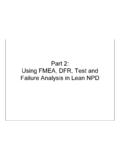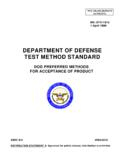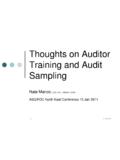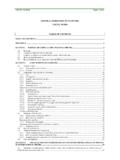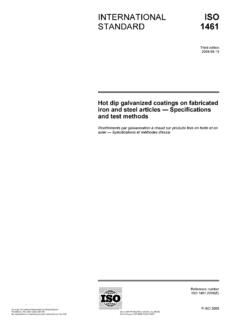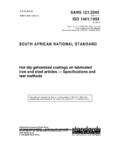Transcription of I. TECHNICAL MATHEMATICS (16 Questions)
1 BODY OF KNOWLEDGE. CERTIFIED QUALITY INSPECTOR. The last administration of this current Quality Inspector Body of Knowledge will be March 2, 2012. The topics in this body of knowledge include additional detail in the form of subtext explanations and the cognitive level at which the questions will be written. This information will provide useful guidance for both the Exam Development Committee and the candidate preparing to take the exam. The subtext is not intended to limit the subject matter or be allinclusive of what might be covered in an exam. It is meant to clarify the type of content to be included in the exam. The descriptor in parentheses at the end of each entry refers to the maximum cognitive level at which the topic will be tested. A complete description of cognitive levels is provided at the end of this document. I. TECHNICAL MATHEMATICS (16 Questions). A. Basic Shop Math Solve basic shop problems using addition, subtraction, multiplication, division, fractions, decimals, squares, and square roots.
2 Use various methods to obtain significant digits for positive and negative numbers, including truncating, rounding up, and rounding down. (Application). B. Basic Algebra Solve or simplify first-degree and single-variable equations. (Application). C. Basic Geometry Calculate general parameters such as area, circumference, perimeter, and volume for basic geometric shapes, and calculate complementary and supplementary angles. (Application). D. Basic Trigonometry Compute angles and lengths using such trigonometric functions as sine, cosine, tangent, and the Pythagorean theorem. (Application). E. Measurement Systems Convert like-units between SI, English, and metric measurement systems ( , inch-micro-inch, liter-quart, meter-millimeter). (Application). F. Measurement Conversions Use various numbering methods such as scientific notation, decimals, and fractions, and convert values between these methods. (Application). II. METROLOGY (30 Questions). A. Common Gages and Measurement Instruments 1.
3 Variable gages Identify and use variable gages, including micrometers, calipers, thread wires, pitch micrometers, linear scales, etc. (Application). 2. Attribute gages Identify and use attribute gages, including snap, plug, and thread gages, gage blocks, pins, etc. (Application). 3. Transfer gages Identify and use transfer gages, including small-hole gages, radius gages, spring calipers, etc. (Application). 4. Measurement scales Describe and distinguish between dial, digital, and vernier scales. (Comprehension). B. Special Gages and Applications 1. Electronic gaging Identify and describe basic tools used with electronics such as oscilloscope, multimeter, pyrometer, etc. (Comprehension). 2. Automatic gaging Identify and describe basic components of automatic gaging, such as machine vision, ultrasonic, X-ray, laser, etc. (Comprehension). Note: The use of these components is covered under 3D1. 3. Pneumatic gaging Identify and describe basic components of pneumatic gaging, including air columns, probes, rings, etc.
4 (Comprehension). C. Gage Selection, Handling, and Use 1. Factors in gage selection Select gages according to the feature or characteristic to be measured, the applicable tolerance, the 10:1 rule, etc.; the accuracy, resolution, and capability of the test instrument, and determine whether the type of measurement should be direct, differential, or transfer. (Application). 2. Gage handling, preservation, and storage Identify and apply various methods of cleaning, handling, and storing gages. (Application). 3. Gage correlation Identify and apply methods for establishing the correlation between measurement instruments, such as gage-to-gage or manual-toautomated process. (Application). D. Surface Plate Tools and Techniques 1. Surface plate equipment Select and use height gages, V-blocks, indicators, etc., to measure various types of products. (Application). 2. Angle measurement instruments Identify and use tools such as protractors, sine bars, angle blocks, etc., in various situations.
5 (Application). E. Specialized inspection Equipment 1. Weights, balances, and scales Define and describe how to use these types of tools. (Application). 2. Measuring finish Describe and apply profilometers, profile tracers, fingernail comparators, etc. (Application). 3. Measuring shape and profile Describe and apply various types of comparators, roundness testers, precision spindles, etc. (Application). 4. Optical equipment Describe and apply optical comparators, optical flats, microscopes, reference specimens, etc. (Application). 5. Digital vision systems Define and describe how digital cameras, online surface inspection , and other digital systems are used in quality inspection . (Comprehension). 6. Coordinate measuring machine (CMM). Explain the basic operation of a CMM, including use of the x, y, and z axes, and the limitations of locating functional datums, target points, and target areas. (Application). F. Calibration 1. Calibration systems Describe the principles of calibration, including its basic purpose, methods of establishing and monitoring calibration intervals, records, coding schemes, etc.
6 (Application). 2. Calibration standards Describe the hierarchy of standards, from working standards through international standards. (Comprehension). 3. Equipment traceability Describe the requirements for documenting traceability to standards. (Comprehension). 4. Gage calibration environment Describe the effects that environmental conditions, such as temperature, humidity, vibration, the cleanliness of the gage, etc., can have on the calibration process. (Application). 5. Out-of-calibration effects Describe the effects that out-of-calibration instruments can have on product acceptance and the actions to take in response to this situation. (Application). G. Measurement System Analysis Define and describe various elements, including identifying and measuring bias, stability, accuracy, linearity, etc., and reviewing repeatability and reproducibility (R&R) studies. (Comprehension). III. inspection AND TEST (30 Questions). A. Geometric Dimensioning and Tolerancing (GD&T). 1. Blueprints and engineering drawings Define and interpret various sections of TECHNICAL drawings, including title, tolerance, and revision blocks, notes, scale, etc.
7 (Application). 2. Terminology and symbols Define and interpret drawing views, details, etc., for product specifications or other controlling documents, and define and use various terms and symbols from the ASME Standard. (Application). 3. Position and bonus tolerances Calculate these from various drawings. (Analysis). 4. Part alignment and datum structure Determine part alignment and setup using the datum structure. (Analysis). B. Sampling Define and interpret terms such as acceptable quality level (AQL), random sampling, lot size, acceptance number, sampling plans, inspection type, timeliness, etc. (Application). B. inspection Planning and Procedures 1. inspection planning Define and distinguish between inspection types such as incoming material, first article (first piece), in-process, final, etc., and identify in what order they should be applied. (Application). 2. inspection errors Identify potential inspection errors such as bias, fatigue, flinching, distraction, etc.
8 (Application). 3. Product traceability Identify methods to trace products and materials such as age control, shelf life, and first-in first-out (FIFO). (Application). 4. Identification of nonconforming material Describe various methods of identifying nonconforming material such as tagging, labeling, and segregating. (Application). 5. Levels of severity Determine levels of severity, such as critical, major, and minor classification of product features and defects. (Application). 6. Reporting of nonconforming material Describe the reporting of nonconforming material for disposition, such as material review board (MRB), rework, reprocess, scrap, and customer waiver. (Application). C. Testing Methods 1. Nondestructive testing Define methods such as X-ray, eddy current, ultrasonic, dye penetrant, and magnetic particle. (Knowledge). 2. Destructive testing Define methods such as tensile, force testing, and leak testing. (Knowledge). 3. Functionality testing Define methods such as tension, torque, and compression.
9 (Knowledge). 4. Hardness testing Classify and apply methods such as Brinell, Rockwell, Durometer, and micro-hardness test. (Application). 5. Verification of software for test equipment Identify and define basic steps to ensure that the software for test equipment adequately and correctly performs its intended functions by safeguarding, functional checks, comparison of test results, and identification of attributes and parameters. (Knowledge). IV. QUALITY ASSURANCE (24 Questions). A. Basic Statistics and Applications 1. Measures of central tendency Calculate mean, median, and mode. (Application). 2. Measures of dispersion Calculate range, standard deviation, and variance. (Application). 3. Measures of proportion or percentage Calculate these measures for various data sets. (Application). 4. Graphical displays Define, interpret, and distinguish between graphical displays, such as histograms, scatter diagrams, tally sheets, bar charts, etc., and apply them in various situations.
10 (Application). 5. Normal distribution Define the characteristics of a normal distribution, such as symmetry, bell curve, central tendency, etc. (Comprehension). B. Statistical Process Control (SPC). 1. Common and special causes Explain the difference between these causes of variation. Determine whether a process is in or out of statistical control by analyzing data patterns (runs, trends, hugging, etc.), and identify what actions should be taken in response. (Evaluation). 2. Control limits vs. specification limits Define, describe, and distinguish between these types of limits. (Application). 3. Variables charts Identify characteristics and uses of X R and X s charts. (Application). 4. Attributes charts Identify characteristics and uses of p, np, c, and u charts. (Application). 5. Process capability analysis Define and distinguish between Cp, Cpk, Pp, and Ppk, and apply them to various data sets. (Application). C. Quality Improvement 1. Terms and concepts Define basic quality improvement concepts such as prevention versus detection, the importance of customer satisfaction, the cost of poor quality, total quality management (TQM), etc.
